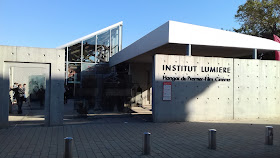The Lumière film festival is wrapping up as I write. Lyon is the city where film was invented, more or less, by the Lumière brothers, and the festival, a recent invention, only in its ninth year, is a tribute to that history. It is not a showcase for new films, but a massive course in film history, from the French perspective. The big – or biggest – retrospective features were for Wong Kar-wai, Henri-Georges Clouzot, and Harold Lloyd, which gives an idea of the scope. It is a festival where five thousand people fill a giant hall to see Wong Kar-wai’s In the Mood for Love, and on another night five thousand fill the same space to see The Lion King.
I have perhaps alluded in the past to some aspects of French culture that I envy. The Lumière festival was in this sense a painful week for me. I will describe a single event.
Here we see the Hangar of the First Film at the Institut Lumière. The festival’s screenings are scattered all over the city, but this theater is the headquarters. The movie theater is literally built on the site of the first film, Workers Leaving the Factory (1895). The theater is built out of and around the remnants of the building featured in the first film ever made.
I mean, come on. I am going to see King Kong (1933) here. I had already been here, before the festival, to see the restorations of Jean Vigo’s L’Atlante and Zero de Conduite. The regular programming of the Institut Lumière is a year-round film festival.
The chairs at the hangar have little brass plaques on the arms with the names of important filmmakers. I am sitting “between” Buster Keaton and Stanley Kubrick. As with every event at the festival, nearly every seat is filled, a substantial number of them by schoolchildren. Almost every film I saw was attended by school groups. Every film is introduced, often by someone well-known. A random early Clouzot movie I saw was introduced by Vincent Perez. But this time we get:
On the left is the director of the festival; in the center is Bertrand Tavernier, president of the Institut and one of France’s greatest living directors; on the right is Michel Le Bris, who is talking about (see screen) Kong, his new 950-page novel about the directors of King Kong. Le Bris is among other things a Robert Louis Stevenson expert. How I would like to read this book. Maybe someday.
My point is that at a screening of King Kong, the first twenty minutes are spent in the discussion of a novel, and the film itself is discussed as if it is something serious, as if it is a work of art, and this is all taken as entirely normal not just by the film buffs but by a hundred or two French school kids.
To top it off, Tavernier, who presumably has things to do, sits down to watch King Kong with the rest of us. Afterwards, on the way out, I speak to him. I tell him that he had created a beautiful film festival.




